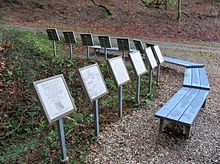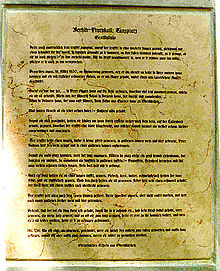Christine Teipel
Christine Teipel (b. 1621; † May 4, 1630) was executed as a witch in Oberkirchen in the Sauerland region of Germany and is an example of how children could have an initiating and driving role in witch trials.
Christine ("Stine") Teipel was probably born in Oberkirchen in 1621. Her parents had moved from the neighboring town of Schmallenberg and probably lived in Oberkirchen as hired hands and day laborers; at least the family was the poorest family in the town. After her mother's death, she lived with her father and stepmother, whom she strongly incriminated in the course of the interrogations.
In 1628, Stine Teipel, who was seven years old at the time, began to tell the public, without being asked, that she was a witch, and named 15 adults and one child from the immediate vicinity as participants in the witch dance that she knew. The background for these sudden accusations could possibly be a case of (attempted) child abuse. Those she publicly accused of witchcraft were increasingly isolated by neighbours in the months that followed. In most cases, they were relatives or descendants of people who had been executed in a first wave of witch trials around 1595, so the accusations were apparently considered plausible in many cases. In addition, Stine Teipel claimed to be able to perform magic and, according to her own later statement, also wanted to teach this "art" to playmates.
However, when witch trials had begun throughout the Duchy of Westphalia in 1629, two peasant aldermen started investigations on their own in view of the circulating suspicions and interrogated Stine, who was nine years old by then, on March 7, 1630, without involving the judge. The official investigation of the witchcraft accusations did not begin until a good week later, when the court summoned and interrogated ten witnesses. The suspicions brought forward by these witnesses were based in most cases on the accusations made by Stine Teipel in the previous year and a half; finally, on March 18, the first witch trials began with the renewed interrogation of Stine, who had been imprisoned in the meantime.
Stine herself was very willing to testify in court; her voluntary confession is one of the most extensive in the entire file and is very detailed, especially in the description of the witch dance and the subsequent meal. As a crown witness, so to speak, she had to remain in custody until the beginning of May 1630, until all the trials against those she had accused were over. During a further interrogation, she also accused her stepmother and Grete Halman, also nine years old, of witchcraft. In a lineup, the two girls confirmed to each other that they had seen the other at the witch dance. After Grete had also massively accused her parents, the two girls were executed together with seven adults on May 4, 1630. According to the Oberkirchen court records, the trial itself took place at the same time as the Fredeburg witch trials in Fredeburg; whether the execution then actually took place at the court site near Oberkirchen or in Fredeburg is unclear.
A total of 67 people were accused of witchcraft before the Oberkirchen court in eight weeks and 61 of them were executed, including Stine and her stepmother as well as Grete with her parents, her sister-in-law and three other relatives. Almost all of the accused in the first trials had been incriminated by Stine Teipel, a total of 16 persons, i.e. about a quarter of all the accused; the subsequent trials, in turn, were largely based on the statements in their confessions. Partly directly, partly indirectly, almost all the Oberkirchen witch trials of 1630 are thus connected with the accusations that Stine Teipel had made in public from 1628 onwards and in court in the spring of 1630. Even in 1641, eleven years after her execution, her accusations led to suspicions and at least one indictment and execution.
In the Lüttmecke near Oberkirchen at the Hexenplatz (witch square) plaques remind of the Oberkirchen witch persecutions and the trial of Christine Teipel.
Overall, the case of Christine Teipel is an example of how the initiative for witch trials often came from the population - or in this case, a child - and ultimately set a wave of trials in motion.

Boards at the Hexenplatz in Oberkirchen

Oberkirchen Christine Teipel blackboard witch trial
See also
- Excerpts from the witch trial file of Christine Teipel
- Witch hunt in the Duchy of Westphalia
Search within the encyclopedia